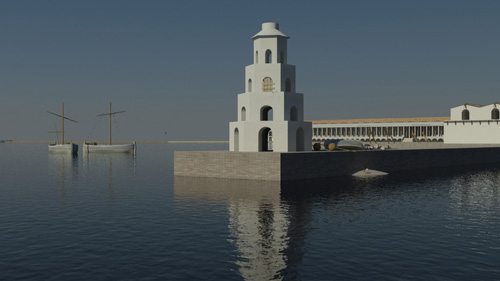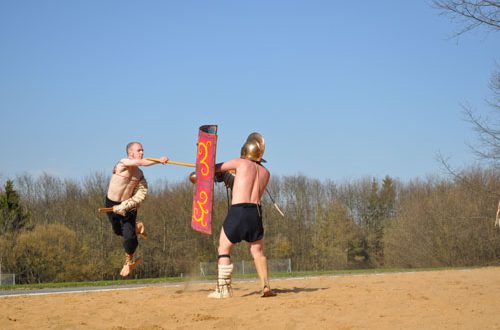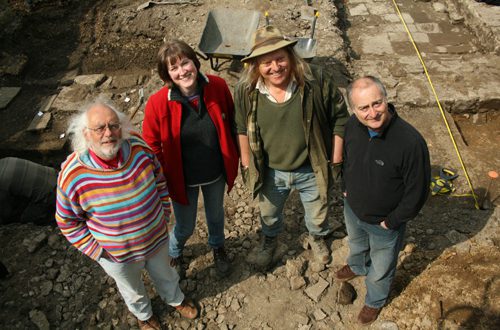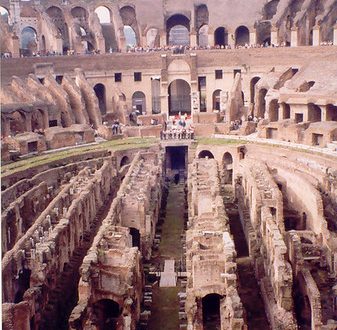 The discovery of a unique amphitheatre and other structures at Rome’s ancient maritime port is putting the archaeological site of Portus on the map. For decades it’s been a much over-looked site next to Fiumicino’s international runway and scholarly attention has focused on neighbouring Ostia Antica, but experts now believe it is a unique site that should rank alongside monuments such as Stonehenge or Angkor Wat. I spoke to Professor Simon Keay, director of the Portus Project and leading expert in Roman archaeology at the University of Southampton and the British School at Rome about the findings of the excavation, and why he describes the amphitheatre of Portus as “a very enigmatic structure… almost like a new architectural type”.
The discovery of a unique amphitheatre and other structures at Rome’s ancient maritime port is putting the archaeological site of Portus on the map. For decades it’s been a much over-looked site next to Fiumicino’s international runway and scholarly attention has focused on neighbouring Ostia Antica, but experts now believe it is a unique site that should rank alongside monuments such as Stonehenge or Angkor Wat. I spoke to Professor Simon Keay, director of the Portus Project and leading expert in Roman archaeology at the University of Southampton and the British School at Rome about the findings of the excavation, and why he describes the amphitheatre of Portus as “a very enigmatic structure… almost like a new architectural type”.
HK: You’ve just announced these discoveries but over what period of time did they come to light?
SK: We’ve been working on the site for three years now and we first discovered some of the concentric walls that belong to the amphitheatre during the first two years of the project. But it’s a big building and before we could be certain it was an amphitheatre we needed to excavate another part of the site to complete the plan. We’ve now done that and we can confirm that it is an amphitheatre in shape. We’ve got a good fix on its chronology and we’re getting some important clues as to how it might have been used. So it’s been quite a slow process and as with all research it takes a bit of time to be sure about one’s findings.
HK: What do you know so far about the use of the amphitheatre?
SK: I’ll give you a bit of background first because that’s really relevant. The amphitheatre is located adjacent to a very important building known as the ‘palazzo imperiale’ or ‘imperial palace’. This building was built by the emperor Trajan as part of his enlargement of the port of imperial Rome, Portus, he also added a new hexagonal basin, some 32 hectares in size, to the suite of basins that comprised the port. The palazzo imperiale lies between the two big basins of the port. It was a very well-appointed building and probably the head quarters of a major official who managed many of the activities in the port for much of the second century. The palace was probably finished in around 116-117 AD. For about a hundred years it was the centre of life in the port and then about 100 years after its construction, in the early third century, there was a major reform of the palace and the palace structure and we see this very large amphitheatre being built on the eastern side of the palace complex. It’s 42m by 38m, so it’s not massive and the other thing about it is that, unlike many other amphitheatres, it’s not built to be seen from a distance. It’s actually quite a discrete building and nestles between the imperial palace and two other buildings that flank the palace close to the harbour’s edge (one warehouse-type building and a cistern block). The amphitheatre is at the heart of this palace complex and was probably associated with a public official who took over at the palace in the early third century a man known as the ‘procurator of both basins’ (procurator Portus Utriusque).
The structure as we have it consists on the side closest to the palace of a semicircular wall, which would have supported a massive colonnade, part of the palace wall. Part of the amphitheatre fitted neatly into that wall and the rest of it extended out away from the palace.
Most of what survives from the amphitheatre consists of concrete foundations sunk into the sand at a depth of about 2m, and there’s very little of it actually above ground, which means it’s quite difficult for us to calculate the number of seats it would have held and the number of people that would have used it. Nevertheless, I think in terms of hundreds of people using it. And probably in terms of what actually went on there, we think that probably this was a place where the procurator, the public official of the third century, would have addressed the people who worked in the palace or people who worked in the port as a whole or a place for them to communicate verbally, which was very important.
Another possibility is that this was a place where there were gladiatorial combats of some kind or wild beast baiting. Yet another possibility given that there are fresh water cisterns nearby, is that mock sea battles with small boats (naumachia) would have been held here. We don’t have any real evidence for any of these yet, but we’re certainly convinced by looking very closely at what we’ve found and by creating 3D computer reconstructions (more detailed than the ones we’ve done so far), that we will eventually crack the interpretation and understand what the amphitheatre was used for.
BK: Since the amphitheatre was within the ‘imperial palace’ complex, was its use private or public?
SK:It’s a difficult question. It’s clearly a public building by definition an amphitheatre is a place where people come together to observe spectacles. But it’s not an amphitheatre that would have served the general public of Portus, Ostia and the surrounding countryside in the way that the amphitheatres in Rome itself or El Djem in Africa would have done. So I think in a sense it was a semi-public building, part of a major palace complex, which would have drawn some people from the port. The point about it is that it was not not very visible. It’s actually a very enigmatic structure, which is so much more exciting it’s almost like a new architectural type: an amphitheatre, in a harbour context, adjacent to a palace complex, in this situation, is really quite new. I think it has a lot to teach us about the cultural aspirations of officials in the second and third centuries AD in the Roman empire.
BK: How closely associated would the imperial palace and the amphitheatre have been with any of the Roman emperors such as Trajan or Hadrian?
SK: The palace itself was primarily an administrative building, built initially by Trajan. However, Portus was the principal maritime port of Rome and was the main point of contact between Rome and the Mediterranean. We know that emperors such as Hadrian travelled around the empire a lot, so it’s very possible that they would have passed through Portus to get on a ship and travel. If they did that, then it’s possible that our imperial palace could have served temporarily as an imperial residence. That’s not impossible but its primary purpose was administrative.
BK: Why do you think the site of Portus hasn’t been fully excavated until now?
SK: A lot of scholarly attention has always been captured by Ostia, the river-port of Rome, which is a very short distance from here. Ostia, in many ways, tells us so much in terms of the port of Rome, the officials that congregated there, the families that lived there, houses, places where merchants struck up contracts and that in a sense has often been enough to answer many scholarly questions. But it seems to me that Portus offers more it’s the place where the big cargo ships came in, where imports were stored, before they were transported to Rome. It just hadn’t been much in vogue, but I think our work, along with that of our Italian colleagues at other parts of Portus, shows that, when we look at Portus together with Ostia, we finally start to get an idea of the scale and complexity of Rome’s trade with the Mediterranean.
BK: Are more discoveries at the site likely?
SK: We’ve been funded by the Arts and Humanities Research Council for a three-year period. Our phase of work at this stage is finished, but we very much hope that our Italian colleagues like our work and that we’ll be able to come back and continue it at a subsequent date, hopefully not too far in the distant future, provided we can win more funds.
BK: You mentioned in a press release that this site is as important as Stonehenge or Angkor Wat why is that?
SK: There was only one imperial Rome and imperial Rome only had one maritime port. Also because Portus can tell us so much about the development of Rome as an imperial capital, in terms of its decoration, its population, the food that was consumed, the architecture and so on. So much of that can be explained by the existence of Portus, so clearly, understanding more about it means we can understand Rome better. Therefore it must be important – it must rank highly because it’s unique. There’s nowhere else like Stonehenge. There’s nowhere else like Angkor Wat. There’s nowhere else like Portus!
The Portus Project was carried out by the University of Southampton, the British School at Rome, Soprintendenza per i Beni Archeologici di Ostia, and Cambridge University.
Professor Simon Keay will present a lecture The Re-Discovery of the Imperial Palace at Portus, the port of Ancient Rome at the Turner Sims Concert Hall, Highfield Campus, University of Southampton at 6pm, 21 October 2009.



